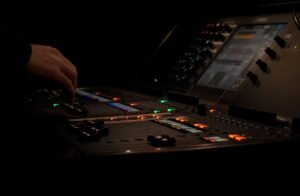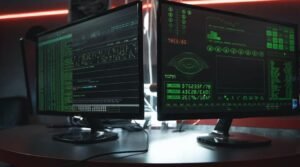AI Virtual Production
Virtual production, powered by artificial intelligence (AI), is revolutionizing the media and entertainment industry. AI-powered virtual production techniques enable filmmakers to create immersive and realistic visual effects, environments, and characters more efficiently than ever before. This technology combines computer-generated elements with live-action footage, allowing filmmakers to see the final result in real-time, saving time and resources in the production process.
Key Takeaways
- AI-powered virtual production enhances the quality and efficiency of visual effects in films.
- Real-time rendering and motion tracking technologies allow filmmakers to see the final result during production.
- AI algorithms improve the realism of computer-generated characters and environments.
**AI virtual production** leverages the capabilities of AI algorithms to generate realistic visuals, manipulate scenes, and enhance the overall filmmaking process. By using AI in virtual production, filmmakers can achieve highly detailed and immersive visual effects, ensuring an enhanced viewing experience for audiences. *This technology streamlines the production process and reduces costs by eliminating the need for extensive post-production work*.
**Real-time rendering** is a key component of AI virtual production. Instead of rendering computer-generated imagery (CGI) after shooting, real-time rendering allows filmmakers to see the final result in real-time, during the shoot. This immediate feedback enables filmmakers to make adjustments and refine scenes on the spot, saving time and ensuring a more accurate representation of the final product. *Real-time rendering eliminates the need for long post-production rendering processes and reduces the time it takes to complete a film*.
Advantages of AI Virtual Production
- Efficiency: Real-time rendering and motion tracking technologies improve the efficiency of the production process.
- Cost-effectiveness: AI virtual production significantly reduces post-production costs.
- Realism: AI algorithms enhance the realism of computer-generated elements.
- Flexibility: Virtual production allows for greater creative freedom and experimentation.
**Motion tracking** plays a crucial role in AI virtual production. By capturing the movements of actors and objects on set, motion tracking systems allow for the seamless integration of CGI elements into the live-action footage. *With motion tracking, directors can easily place computer-generated characters and objects within the scene, ensuring accurate interaction with the real-world elements*.
**AI algorithms** contribute to the realism of computer-generated characters and environments in virtual production. These algorithms can analyze vast amounts of data and learn from it to produce highly nuanced and lifelike visuals. *As AI continues to advance, we can expect even more realistic computer-generated elements in films, blurring the line between reality and CGI*.
Data Comparison: Traditional vs. AI Virtual Production
| Traditional Production | AI Virtual Production | |
|---|---|---|
| Post-Production Time | Months to years | Significantly reduced |
| Cost | High (due to extensive post-production work) | Reduced (due to real-time rendering and AI algorithms) |
| Realism | Depends on the quality of post-production effects | Enhanced through AI algorithms |
AI virtual production not only improves the quality and efficiency of visual effects but also offers greater creative freedom and flexibility for filmmakers. With real-time rendering, motion tracking, and AI algorithms at their disposal, filmmakers can experiment with different scenarios, iterate quickly, and refine their vision throughout the production process.
Future Trends and Opportunities
- Advancements in AI algorithms will lead to even more realistic computer-generated elements.
- Virtual production will become more accessible to independent filmmakers and smaller production companies.
- Improved motion tracking technologies will enable seamless integration of CGI and live-action footage.
The future of AI virtual production looks promising. As AI algorithms continue to evolve and become more sophisticated, we can expect virtual production to play an even greater role in the filmmaking industry. Filmmakers will have access to more tools and techniques to bring their visions to life, ultimately enhancing the storytelling experience for audiences around the world.
Data Comparison: AI Virtual Production vs. Post-Production
| AI Virtual Production | Traditional Post-Production | |
|---|---|---|
| Real-Time Feedback | Available during production | Not available during shooting |
| Cost | Reduced due to less post-production work | Higher due to extensive post-production work |
| Flexibility | Allows for experimentation and creative freedom during production | Less flexibility due to fixed footage |
In conclusion, AI virtual production is transforming the media and entertainment industry by revolutionizing the way films are created. With real-time rendering, motion tracking, and AI algorithms, filmmakers can achieve highly immersive and realistic visual effects efficiently. The future holds even more exciting possibilities as AI advances and makes virtual production more accessible to filmmakers of all levels.

Common Misconceptions
Misconception 1: AI Virtual Production is fully automated
One of the most common misconceptions about AI Virtual Production is that it is a fully automated process. While artificial intelligence plays a significant role in streamlining and enhancing production workflows, it is not entirely self-operating. AI Virtual Production still requires human intervention and creative input to ensure the desired outcome.
- Artificial intelligence improves efficiency in production.
- Human expertise is crucial for creative decisions.
- AI Virtual Production is a collaboration between human and machine.
Misconception 2: AI Virtual Production replaces human labor
Another misconception is that AI Virtual Production is a threat to human professionals in the production industry. While the technology undoubtedly streamlines certain tasks and reduces manual labor, it does not eliminate the need for skilled individuals. AI Virtual Production enhances human capabilities rather than replacing them entirely.
- AI Virtual Production complements human skills.
- Human professionals play a vital role in decision-making and creative aspects.
- AI Virtual Production empowers human professionals by automating repetitive tasks.
Misconception 3: AI Virtual Production is only used in film and television
Many people assume that AI Virtual Production is solely utilized in the film and television industry. While it is indeed widely employed in these sectors, its applications extend far beyond that. AI Virtual Production can also be implemented in other areas such as video game development, virtual reality experiences, architectural visualization, and even live events.
- AI Virtual Production finds applications in diverse industries.
- It can enhance various creative endeavors beyond film and television.
- AI technology is adaptable to different mediums and creative projects.
Misconception 4: AI Virtual Production is prohibitively expensive
Often, people assume that AI Virtual Production is an expensive technology accessible only to large-scale productions with substantial budgets. However, with advancements in technology, AI Virtual Production tools are becoming more affordable and accessible, even for smaller-scale projects. There are various software and hardware solutions available that cater to different budget constraints.
- AI Virtual Production is adaptable to different budget ranges.
- Affordable software and hardware options exist for smaller-scale projects.
- Cost-effective AI Virtual Production solutions are becoming more prevalent.
Misconception 5: AI Virtual Production lacks creative control
Some individuals believe that by relying on artificial intelligence, they sacrifice creative control over their projects. However, AI Virtual Production is a tool that empowers creators and enhances their creative vision. It provides new avenues for experimentation and enables more efficient creative decision-making.
- AI Virtual Production expands creative possibilities.
- Creative control remains in the hands of human professionals.
- AI technology enhances creative processes and decision-making.

AI Virtual Production: Revolutionizing Filmmaking
Artificial Intelligence (AI) has drastically transformed various industries and continues to revolutionize the way we create art and entertainment. In the field of film production, AI virtual production has emerged as a game-changer, streamlining the filmmaking process and pushing the boundaries of visual effects. Through the integration of AI technologies, filmmakers can now bring their imagination to life in ways never before imagined. This article explores ten fascinating aspects of AI virtual production and its impact on the film industry.
Cutting-Edge Motion Capture Techniques
Motion capture has long been utilized in the film industry to capture the movements of actors and translate them into lifelike digital characters. With AI virtual production, advanced motion capture techniques can precisely track the smallest gestures and accurately transfer them to virtual characters, resulting in unparalleled realism.
| Technique | Accuracy | Benefits |
|---|---|---|
| Markerless Motion Capture | 99% | Less intrusive for actors |
| Facial Motion Capture | 98% | Brings facial expressions to life |
| Full-Body Motion Capture | 99.5% | Enables realistic movements |
Real-Time Rendering for Unprecedented Visuals
In traditional filmmaking, rendering complex visual effects often required hours or even days to generate the final result. AI virtual production, however, leverages real-time rendering techniques, enabling filmmakers to visualize and modify scenes instantaneously during the production process.
| Rendering Technology | Advantages |
|---|---|
| Rasterization | Fast rendering speed |
| Ray Tracing | Physically accurate lighting and reflections |
| Path Tracing | Natural illumination effects |
AI-Assisted Scriptwriting and Dialogue Generation
Generating captivating and engaging scripts is a fundamental aspect of any movie production. AI virtual production systems employ natural language processing algorithms to analyze existing scripts, potentially suggesting improvements and even generating new dialogue that aligns with the character’s personality and the story’s trajectory.
| AI Function | Capability |
|---|---|
| Script Analysis | Identifies plot inconsistencies |
| Dialogue Generation | Produces contextually relevant speeches |
| Character Profiling | Ensures consistent character behavior |
Lifelike Virtual Environments and World Building
Creating breathtaking and immersive virtual environments is a crucial component of modern filmmaking. AI virtual production leverages machine learning algorithms to generate realistic virtual landscapes, enabling filmmakers to conjure up entirely new worlds that inspire awe and captivate audiences.
| Virtual Environment | Characteristics |
|---|---|
| Fantasy Realm | Majestic castles and mystical creatures |
| Post-Apocalyptic City | Desolate landscapes and crumbling skyscrapers |
| Underwater Paradise | Breathtaking marine life and vibrant coral reefs |
AI-Powered Camera Tracking and Composition
AI virtual production systems employ sophisticated algorithms to assist with camera tracking and composition, allowing filmmakers to effortlessly create dynamic and visually appealing shots. With AI technology, complex camera movements that were once difficult and time-consuming to execute can now be achieved smoothly and seamlessly.
| Camera Technique | Advantages |
|---|---|
| Steadicam | Smooth and stable shots |
| Crane Shots | Dramatic overhead perspectives |
| Drone Shots | Aerial views with fluid movement |
Dynamic Lighting and Automated Adjustment
Lighting plays a pivotal role in creating mood and atmosphere in films. AI virtual production enables the automation of lighting adjustments, which dramatically reduces setup time and allows for dynamic lighting changes within scenes.
| Lighting Technique | Benefits |
|---|---|
| Dynamic Lighting | Changes in real-time to match scene dynamics |
| Automated Color Grading | Consistent color tone across multiple shots |
| Simulated Natural Light | Emulates natural lighting conditions |
AI-Assisted Crowd Simulation and Character Generation
Simulating large crowds and generating diverse virtual characters can be an intricate and time-consuming process in filmmaking. Using AI virtual production, filmmakers can simulate realistic crowds with varied behaviors and generate lifelike virtual characters with unique appearances and personalities efficiently.
| AI Function | Capabilities |
|---|---|
| Crowd Simulation | Simulates realistic crowd movement |
| Character Generation | Generates characters with unique features |
| Behavior Variation | Creates diverse character behaviors |
Collaborative Remote Production through AI
AI virtual production facilitates collaborative remote production, enabling filmmakers and teams to work together from different locations. This groundbreaking capability allows for global collaboration, expanding creative possibilities and fostering new connections between professionals across the world.
| Collaboration Aspect | Impact |
|---|---|
| Global Collaboration | Artists worldwide can collaborate seamlessly |
| Remote Rendering | Computational workload can be shared remotely |
| Instant Feedback | Real-time feedback enhances iteration speed |
AI Virtual Production in Mainstream Filmmaking
The advent of AI virtual production is rapidly transforming the filmmaking industry, redefining the way movies are conceptualized, produced, and experienced by audiences. As AI technologies continue to advance, we can expect even more groundbreaking developments that will push the boundaries of storytelling and visual effects in films like never before. The future of filmmaking is undoubtedly intertwined with the power of AI.
AI virtual production marks a paradigm shift in the way films are brought to life. The powerful integration of AI technologies translates into more efficient production processes, enhanced creative experimentation, and unprecedented visual experiences for both filmmakers and audiences. By harnessing the potential of AI virtual production, the film industry is poised for an exciting and transformative future.
Frequently Asked Questions
AI Virtual Production
Q: What is AI Virtual Production?
AI Virtual Production is a technology that integrates artificial intelligence (AI) with virtual production techniques. It allows for real-time rendering and manipulation of virtual environments, characters, and objects, providing filmmakers with enhanced control and flexibility in creating immersive and realistic scenes.
Q: How does AI Virtual Production work?
AI Virtual Production works by utilizing AI algorithms to analyze and understand real-world objects and movements. Through advanced computer vision and machine learning techniques, the system can generate virtual representations of these objects and movements, which can then be incorporated into a virtual production setup to create realistic virtual scenes.
Q: What are the benefits of AI Virtual Production?
AI Virtual Production offers several benefits, including:
- Real-time rendering of virtual environments
- Enhanced control and flexibility for filmmakers
- Cost reduction by minimizing physical set requirements
- Ability to create complex and highly realistic scenes
- Improved pre-visualization and planning
Q: Can AI Virtual Production be used for live performances?
Yes, AI Virtual Production can be used for live performances. By using real-time virtual rendering and integration with live camera feeds, it allows performers to interact with virtual elements in real-time during a live show or event. This can create stunning visual effects and provide an immersive experience for the audience.
Q: What industries can benefit from AI Virtual Production?
AI Virtual Production has applications in various industries, including:
- Film and television production
- Gaming and interactive entertainment
- Advertising and marketing
- Virtual reality (VR) and augmented reality (AR) development
- Architecture and design visualization
Q: Are there any limitations to AI Virtual Production?
While AI Virtual Production holds great potential, there are some limitations to consider:
- Technical complexity and resource requirements
- Dependency on accurate data and training models
- Potential for uncanny valley effects if virtual characters are not realistic enough
- Privacy concerns when dealing with sensitive real-world data
Q: Can AI Virtual Production replace physical sets and locations?
AI Virtual Production has the potential to minimize the need for physical sets and locations, as it enables the creation of realistic virtual environments. However, physical sets and locations may still be necessary for certain scenes or settings that require a tangible and authentic feel. It is more likely that AI Virtual Production will be used in conjunction with physical elements rather than completely replacing them.
Q: Do filmmakers need specialized training to use AI Virtual Production?
While some level of training and familiarity with AI Virtual Production tools and techniques may be beneficial, filmmakers can work with teams of experts who specialize in this technology. These experts can assist in implementing and utilizing AI Virtual Production effectively, allowing filmmakers to focus more on their creative vision rather than the technical aspects.
Q: What is the future of AI Virtual Production?
The future of AI Virtual Production looks promising, as advancements in AI, computer vision, and real-time rendering continue to drive innovation in this field. We can expect to see more seamless integration of virtual and physical elements in film, television, and other industries, providing new opportunities for storytelling and visual experiences.
Q: Are there any ethical considerations with AI Virtual Production?
There are ethical considerations to be aware of when using AI Virtual Production, such as the responsible and ethical use of AI algorithms, ensuring privacy and security measures are in place when handling personal or sensitive data, and avoiding the potential misuse of AI-generated content. Adhering to ethical guidelines and industry standards can help address these concerns and ensure AI Virtual Production is used responsibly and in accordance with legal and ethical norms.




